The impact of the global pandemic on supply chains is still very much a reality, bringing inflation to levels not seen in thirty years. Add on to that the crisis in Ukraine—a country that supplies a large portion of the world’s wheat, fertilizer, and a staggering 50% of the neon gas required for semiconductor production—and it has never been more clear to consumers and practitioners alike that supply chains have a huge impact on daily quality of life.
At the same time, the imperative for addressing sustainability in supply chains has never been more critical. More than half of annual greenhouse gas emissions come from just eight global industries, with more of these emissions coming from supply chain activities than from actual manufacturing. The Fast Moving Consumer Goods (FMCG) industry in particular has become a serious focus of consumers and governments interested in sustainability because it is primarily responsible for the single-use plastic packaging that makes up roughly half of global plastic waste generation—and whose production is a major source of greenhouse gas emissions as well.
The Greenhouse Gas (GHG) Protocol Corporate Standard identifies three scopes of focus for reducing greenhouse gas emissions.
- Scope 1 refers to direct emissions from activities that are owned or controlled by a company like manufacturing.
- Scope 2 covers indirect emissions from energy consumed by the company like electricity.
- Scope 3 induces all other sources of emissions in the value chain like supply chain operations, employee travel, and the use of the sold products.
Furthermore, supply chain emissions included in Scope 3 are in fact 5.5x larger than emissions from Scope 1 and 2 combined. Thus, reducing waste in FMCG supply chains is one of the largest opportunities to have a positive impact on the reduction of greenhouse gas emissions and to keep more waste out of the environment.

So, what are the challenges in reducing waste in supply chains that would drive down Scope 3 emissions? And what can be done to address these challenges?
Let’s answer those questions, starting with the challenges with supply chains that lead to waste and Scope 3 emissions.
The Supply Chain Sustainability Challenge
One of the major challenges in supply chains is often referred to as the “bullwhip effect”. As suppliers respond to demand changes, delays in visibility and information add inaccuracy to the responses, which cascade and magnify through each level of the supply chain. This magnifying effect means that greater demand volatility causes greater waste. And unfortunately, while demand uncertainty is bad now, it is only going to get worse.
The foundation for demand unpredictability is the accelerating pace of innovation in products and promotions to meet the changing preferences of consumer demographics. For example, in the 1990s, Nike underestimated the prevalence and power of ethical consumers who boycotted Nike products around the world, reducing demand such that by 1998, then-CEO Phil Knight ordered a wave of layoffs and was forced to admit that, “The Nike product has become synonymous with slave wages, forced overtime, and arbitrary abuse.”
On top of changing preferences, there is a continuous stream of disruptive events that throw off demand forecasts. Everyone is familiar with the 2020 worldwide toilet paper shortage caused by COVID-19 panic-buying. But what people may not realize is that for this single product alone there was also a shortage in 2013 in Venezuela, where the government had to take control of a toilet paper manufacturing plant. And 40 years before that, Johnny Carson triggered his 20 million viewers to clear stores of toilet paper and create a shortage out of nowhere with a simple joke.
No matter how hard we try to predict demand, the odds are stacked against us and demand will continue to be volatile, resulting in not only expediting, but also excess production, employee travel, and building and equipment operation—all of which still use primarily fossil fuels. This is not even mentioning products and materials that never get sold and are wasted due to obsolescence.
Solving Supply Chain Sustainability
It is well recognized that one of the challenges with decarbonizing supply chains is just getting the visibility into suppliers required to measure Scope 3 emissions. However, I believe that improved visibility can and must do more than just improve measurement. It is the critical foundation for actually driving down emissions and waste in the supply chain precisely because improved visibility is the keystone to reducing the impact of the bullwhip effect.
Improvements in technology for visibility into extended supply chains are now providing an opportunity to improve collaboration and the efficiency of the working relationship between customers and suppliers, which benefits both the businesses and the environment.
Gartner now recognizes a software category of Multi-Enterprise Supply Chain Business Networks (MESCBN) which enable work and collaboration on business processes across multiple enterprises. These solutions should enable ongoing bidirectional communication so suppliers can be more agile in responding to the inevitable changes in demand without incurring waste. For example, suppliers can get earlier and clearer visibility into forecasts and purchase orders from their customers. In turn, their customers can get a clearer picture of future capacity to better manage orders for products and materials, permitting more efficient production with higher order quantities, or earlier ordering to enable more fuel-efficient full truckload transportation.

Most importantly, when the unexpected occurs and all of these plans go out the window, these MESCBNs enable not only real-time visibility into what is happening with inventory, equipment, labor, and production; they also provide a platform to drive decisions so that adjustments can be made early—and even predictively with the use of artificial intelligence—to avoid delays that necessitate wasteful expediting, to avoid material obsolescence, and to avoid the most expensive waste of all: human capital spent redoing work or toiling with manual processes rather than finding ways to reduce waste in the first place.
In short, MESCBNs allow supply chains to be more agile. Rather than resisting unpredictability, supply chains can embrace it and use the latest technology solutions to be able to adapt quickly and efficiently to changes in demand. This helps reduce waste and improve sustainability, while at the same time improving the bottom line for supply chain partners. This “multiple bottom line” benefit for supply chains makes MESCBN technology an essential way to reduce Scope 3 emissions where everybody wins.
If you are a supply chain leader reading this, I challenge you to take action on climate change now by finding solutions that improve visibility and collaboration in your supply chain. Your boss and the planet will soon thank you for it.
Download our white paper to learn more about how a multi-enterprise platform can prepare your business for the future.



